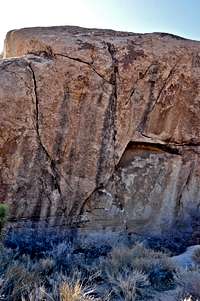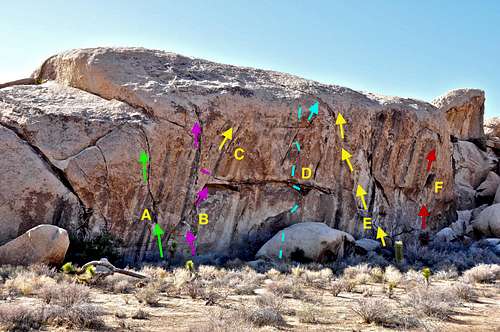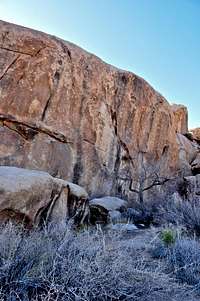-
 5751 Hits
5751 Hits
-
 90.13% Score
90.13% Score
-
 31 Votes
31 Votes
|
|
Area/Range |
|---|---|
|
|
34.02127°N / 116.16296°W |
|
|
Trad Climbing |
|
|
Spring, Summer, Fall, Winter |
|
|
4000 ft / 1219 m |
|
|
Overview
| Note: Joshua Tree National Park is tremendously large and includes thousands of rock formations. The purpose of this page is to bring some sense of organization to many "Mountain & Rock" pages I have posted for the past two years. This particular page may be considered as a mini "Area & Range" page that will be attached to the main Joshua Tree page as a child. |
Getting There
From the western entrance to Joshua Tree National Park drive on Park Boulevard, formerly known as Quail Springs Road, for about nine miles to a major rock formation called “Intersection Rock.” Intersection Rock is a major landmark on the north side of Park Boulevard with ample parking for visitors and climbers alike. This rock, true to its name, sit at the cross roads to Hidden Valley Campground, Barker Dam Road and the road to Day use and picnic area. Park your car here, and walk into Hidden Valley Campground. Walk all the way to the far end of the campground on a paved road. Leave the paved road at this point and follow a trail past the left side of “The Wall,” and “Outhouse” formations. Rock Hudson is the next large formation less than a quarter of a mile from here. The approach to Peyote Cracks and John Bachar Top Rope Wall is done from the Echo Cove area.
Rock Hudson
Rock HudsonPeyote Cracks
Peyote CracksThe name Peyote Cracks evokes scenarios as to why this formation was named as such. Feel free to let your imagination run wild. In any event, I cannot think of any area in the U.S.A. that offers such a vast variety of rock formations as Joshua Tree National Park. You can find face climbs and crack climbs for all abilities with the easiest approaches. Peyote Cracks is one such case. Although the climbs here are not for the very beginners, they are well within the reach of most climbers. And, if you are good enough to think that the climbs of the west face are too boring, all you need to do is to go around to back side of the same rock and knock yourself out.
This formation, simply known as Peyote Cracks, is a single pitch height rock that is long and narrow with, more or less, north south orientation. The west face offers several crack systems ranging in difficulty levels from 5.8 to 10a. There is one route on the extreme left side by the name,Button Soup, that wanders up the rock with a much lower difficulty rating of 5.2. There are also some poorly protected face routes on the right side of the west face that offer a greater challenge for better climbers. To the right of the Right Peyote Crack there is a face route, Face It, rated 10a that has long been a top rope problem. If you feel comfortable on clipping only one bolt and running it out, you can try leading it. I prefer to top rope this one. There is another well-bolted route to the right and around the corner from Face It. Unfortunately, I have no information on the name or the difficulty of this climb.
Outhouse Rock
Outhouse RockSelect climbs of Outhouse Rock | |
| A | Out For a Bite, 10d, TR |
| B | Diagonal Chimney, 5.6, Standard Rack, pro to 3.5" |
| C | Strawberry Jam, 5.9, The best climb on the formation, Standard Rack, pro to 3" |
| D | The Loo Sanction, 10a, bolts and pro to 3" |
| E | Straight Flush, 5.8 Standard Rack, pro to 3" |
| F | Wise Crack, 5.9, standard rack, pro to 3" |









